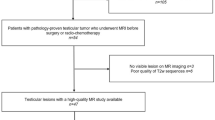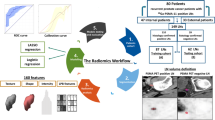Abstract
Objectives
To evaluate whether a computed tomography (CT) radiomics–based machine learning classifier can predict histopathology of lymph nodes (LNs) after post-chemotherapy LN dissection (pcRPLND) in patients with metastatic non-seminomatous testicular germ cell tumors (NSTGCTs).
Methods
Eighty patients with retroperitoneal LN metastases and contrast-enhanced CT were included into this retrospective study. Resected LNs were histopathologically classified into “benign” (necrosis/fibrosis) or “malignant” (viable tumor/teratoma). On CT imaging, 204 corresponding LNs were segmented and 97 radiomic features per LN were extracted after standardized image processing. The dataset was split into training, test, and validation sets. After stepwise feature reduction based on reproducibility, variable importance, and correlation analyses, a gradient-boosted tree was trained and tuned on the selected most important features using the training and test datasets. Model validation was performed on the independent validation dataset.
Results
The trained machine learning classifier achieved a classification accuracy of 0.81 in the validation dataset with a misclassification of 8 of 36 benign LNs as malignant and 4 of 25 malignant LNs as benign (sensitivity 88%, specificity 72%, negative predictive value 88%). In contrast, a model containing only the LN volume resulted in a classification accuracy of 0.68 with 64% sensitivity and 68% specificity.
Conclusions
CT radiomics represents an exciting new tool for improved prediction of the presence of malignant histopathology in retroperitoneal LN metastases from NSTGCTs, aiming at reducing overtreatment in this group of young patients. Thus, the presented approach should be combined with established clinical biomarkers and further validated in larger, prospective clinical trials.
Key Points
• Patients with metastatic non-seminomatous testicular germ cell tumors undergoing post-chemotherapy retroperitoneal lymph node dissection of residual lesions show overtreatment in up to 50%.
• We assessed whether a CT radiomics–based machine learning classifier can predict histopathology of lymph nodes after post-chemotherapy lymph node dissection.
• The trained machine learning classifier achieved a classification accuracy of 0.81 in the validation dataset with a sensitivity of 88% and a specificity of 78%, thus allowing for prediction of the presence of viable tumor or teratoma in retroperitoneal lymph node metastases.





Similar content being viewed by others
Abbreviations
- AFP:
-
Alpha-fetoprotein
- AUC:
-
Area under the curve
- BEP:
-
Bleomycin-, etoposide-, and cisplatin-based polychemotherapy
- CT:
-
Computed tomography
- DICOM:
-
Digital Imaging and Communications in Medicine
- hCG:
-
Human chorionic gonadotropin
- LDH:
-
Lactate dehydrogenase
- LNs:
-
Lymph nodes
- NSTGCT:
-
Non-seminomatous testicular germ cell tumor
- pcRPLND:
-
Post-chemotherapy retroperitoneal lymph node dissection
- PET-CT:
-
Positron emission computed tomography
- ROC:
-
Receiver operating curve
- ROI:
-
Region of interest
- RPLND:
-
Retroperitoneal lymph node dissection
- STARD:
-
Standards for Reporting Diagnostic
- TGCT:
-
Testicular germ cell tumor
References
Rosen A, JayramG DM, Eggener SE (2011) Global trends in testicular cancer incidence and mortality. Eur Urol 60(2):374–379
Klepp O, Flodgren P, Maartman-Moe H et al (1990) Early clinical stages (CS1, CS1Mk+ and CS2A) of non-seminomatous testis cancer. Value of pre- and postorchiectomy serum tumor marker information in prediction of retroperitoneal lymph node metastases. Swedish-Norwegian Testicular Cancer Project (SWENOTECA). Ann Oncol 1(4):281–288
Albers P, AlbrechtW AF et al (2015) Guidelines on testicular cancer: 2015 update. Eur Urol 68(6):1054–1068
Kuczyk M, Machtens S, Stief C, Jonas U (1999) Management of the post-chemotherapy residual mass in patients with advanced stage non-seminomatous germ cell tumors (NSGCT). Int J Cancer 83(6):852–855
Oechsle K, Hartmann M, Brenner W et al (2008) 18FFluorodeoxyglucose positron emission tomography in nonseminomatous germ cell tumors after chemotherapy: the German multicenter positron emission tomography study group. J Clin Oncol 26(36):5930–5935
EAU Guidelines Office (2019) EAUguidelines on testicular cancer. Edn. presented at the EAU Annual Congress Barcelona, Arnhem, The Netherlands
Heidenreich A, Haidl F, Paffenholz P, Pape C, Neumann U, Pfister D (2017) Surgicalmanagement of complex residual masses following systemic chemotherapy for metastatic testicular germ cell tumours. Ann Oncol 28(2):362–367
Winter C, Pfister D, Busch J, Bingöl C, Ranft U, Schrader M et al (2012) Residual tumor size and IGCCCG risk classification predict additional vascular procedures in patients with germ cell tumors and residual tumor resection: a multicenter analysis of the German Testicular Cancer Study Group. Eur Urol 61(2):403–409
Nini A, Konieczny M, Winter C, Lusch A, Krauspe R, Albers P (2018) Surgical management and outcomes of patients with bone metastases in germ cell tumors: a case series. Urol Oncol 36(2):82.e1–82.e5
Leão R, Nayan M, Punjani N, Jewett MAS, Fadaak K, Garisto J et al (2018) A new model to predict benign histology in residual retroperitoneal masses after chemotherapy in nonseminoma. Eur Urol Focus 4(6):995–1001
Steyerberg EW, Gerl A, Fossá SD, Sleijfer DT, de Wit R, Kirkels WJ et al (1998) Validity of predictions of residual retroperitoneal mass histology in nonseminomatous testicular cancer. J Clin Oncol 16(1):269–274
Vergouwe Y, Steyerberg EW, Foster RS, Sleijfer DT, Fosså SD, Gerl A et al (2007) Predicting retroperitoneal histology in postchemotherapy testicular germ cell cancer: a model update and multicentre validation with more than 1000 patients. Eur Urol 51(2):424–432
Obermeyer Z, Emanuel EJ (2016) Predicting the future - big data, machine learning, and clinical medicine. N Engl J Med 375(13):1216–1219
Lambin P, Leijenaar RTH, Deist TM, Peerlings J, de Jong EEC, van Timmeren J et al (2017) Radiomics: the bridge between medical imaging and personalized medicine. Nat Rev Clin Oncol 14(12):749–762
Ng F, Ganeshan B, Kozarski R, Miles KA, Goh V (2013) Assessment of primary colorectal cancer heterogeneity by using whole-tumor texture analysis: contrast-enhanced CT texture as a biomarker of 5-year survival. Radiology 266(1):177–184
Wu S, Zheng J, Li Y, Yu H, Shi S, Xie W et al (2017) A radiomics nomogramfor the preoperative prediction of lymph nodemetastasis in bladder cancer. Clin Cancer Res 23(22):6904–6911
Huang Y-Q, Liang C-H, He L, Tian J, Liang C-S, Chen X et al (2016) Development and validation of a radiomics nomogram for preoperative prediction of lymph node metastasis in colorectal cancer. J Clin Oncol 34(18):2157–2164
Fedorov A, Beichel R, Kalpathy-Cramer J, Finet J, Fillion-Robin JC, Pujol S et al (2012) 3D Slicer as an image computing platform for the Quantitative Imaging Network. Magn Reson Imaging 30(9):1323–1341
Nioche C, Orlhac F, Boughdad S, Reuzé S, Goya-Outi J, Robert C et al (2018) LIFEx: a freeware for radiomic feature calculation in multimodality imaging to accelerate advances in the characterization of tumor heterogeneity. Cancer Res 78(16):4786–4789
Collewet G, Strzelecki M, Mariette F (2004) Influence of MRI acquisition protocols and image intensity normalization methods on texture classification. Magn Reson Imaging 22(1):81–91
van Griethuysen JJM, Fedorov A, Parmar C, Hosny A, Aucoin N, Narayan V et al (2017) Computational radiomics system to decode the radiographic phenotype. Cancer Res 77(21):e104–e107
Zwanenburg A, Leger S, Vallières M, Löck S (2016) Image biomarker standardisation initiative. Accessible online http://arxiv.org/pdf/1612.07003v9
R Core Team. R: a language and environment for statistical computing. Vienna, Austria
Studio Team R (2015) RStudio: integrated development environment for R. RStudio, Inc., Boston
Baessler B, Mannil M, Oebel S et al (2018) Subacute and chronic left ventricular myocardial scar: accuracy of texture analysis on nonenhanced cine MR images. Radiology. 286(1):103–112
Baessler B, Luecke C, Lurz J et al (2018) Cardiac MRI texture analysis of T1 and T2 maps in patients with infarctlike acute myocarditis. Radiology. 289(2):357–365
Lewin J, Dufort P, Halankar J, O’Malley M, JewettMAS HRJ et al (2018) Applying radiomics to predict pathology of postchemotherapy retroperitoneal nodal masses in germ cell tumors. JCO Clin Cancer Informat 2:1–12
Leão R, van Agthoven T, Figueiredo A, Jewett MAS, Fadaak K, Sweet J et al (2018) Serum miRNA predicts viable disease after chemotherapy in patients with testicular nonseminoma germ cell tumor. J Urol 200(1):126–135
AndersenMB HSW, Ganeshan B, Thygesen J, TorpMadsen HH, Rasmussen F (2016) CT texture analysis can help differentiate between malignant and benign lymph nodes in the mediastinum in patients suspected for lung cancer. Acta Radiol 57(6):669–676
Bayanati H, Thornhill ER, Souza CA, Sethi-Virmani V, Gupta A, Maziak D et al (2015) Quantitative CT texture and shape analysis: can it differentiate benign and malignant mediastinal lymph nodes in patients with primary lung cancer? Eur Radiol 25(2):480–487
Tan X, Ma Z, Yan L, Ye W, Liu Z, Liang C (2019) Radiomics nomogram outperforms size criteria in discriminating lymph node metastasis in resectable esophageal squamous cell carcinoma. Eur Radiol 29(1):392–400
Albers P, Weissbach L, Krege S, Kliesch S, Hartmann M, Heidenreich A et al (2004) Prediction of necrosis after chemotherapy of advanced germ cell tumors: results of a prospective multicenter trial of the German Testicular Cancer Study Group. J Urol 171(5):1835–1838
Paffenholz P, Nestler T, Hoier S et al (2019) Independent validation of two models to predict necrosis/fibrosis in post chemotherapy residual retroperitoneal masses of patients with advanced testicular cancer. Eur Urol Suppl 18–827
Funding
The authors state that this work has not received any funding.
Author information
Authors and Affiliations
Corresponding author
Ethics declarations
Guarantor
The scientific guarantor of this publication is Bettina Baeßler.
Conflict of interest
The authors of this manuscript declare no relationships with any companies whose products or services may be related to the subject matter of the article.
Statistics and biometry
One of the authors has significant statistical expertise.
Informed consent
Written informed consent was waived by the Institutional Review Board.
Ethical approval
Institutional Review Board approval was obtained.
Methodology
• Retrospective
• Diagnostic or prognostic study
• Performed at one institution
Additional information
Publisher’s note
Springer Nature remains neutral with regard to jurisdictional claims in published maps and institutional affiliations.
Electronic supplementary material
R packages used for statistical analysis
ESM 1
(DOCX 21 kb)
Rights and permissions
About this article
Cite this article
Baessler, B., Nestler, T., Pinto dos Santos, D. et al. Radiomics allows for detection of benign and malignant histopathology in patients with metastatic testicular germ cell tumors prior to post-chemotherapy retroperitoneal lymph node dissection. Eur Radiol 30, 2334–2345 (2020). https://doi.org/10.1007/s00330-019-06495-z
Received:
Revised:
Accepted:
Published:
Issue Date:
DOI: https://doi.org/10.1007/s00330-019-06495-z




